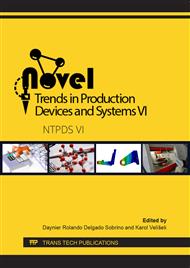p.3
p.11
p.19
p.28
p.36
p.44
p.52
p.62
Fractographic Analysis of Castings from Al-Si Alloy Produced by Low-Pressure Casting
Abstract:
The article deals with the use of newly developed hypoeutectic silumin type AlSi9NiCuMg0.5 in manufacturing practice. This type of silumin has been produced and patented by a team of workers at the Faculty of Mechanical Engineering at the University of J. E. Purkyně in Ústí nad Labem, Czech Republic. This alloy was developed and tested directly for the technical practice where the special mechanical and technological properties of the alloy were required [1]. The experiment, which is presented in this paper, focuses on the cause of the castings cracking in operating conditions. When the material was put into practice, castings were produced and subsequently used for breaking and cracking across the entire casting section. AlSi9NiCuMg0.5 alloy castings were manufactured using low-pressure technology. The research is focused on the observation of the fracture surface, identification of microstructure of AlSi9NiCuMg0.5 alloy casting and determination of the chemical composition of structural components on the surface of fracture by EDS analysis. Fractional field research has measured the chemical composition and it has been compared with the required declared alloy. Increased iron content and associated intermetallic phases were identified in the alloy. Evaluating of the obtained results can identify the cause of the premature cracking of the castings made from the newly developed hypoeutectic silumin.
Info:
Periodical:
Pages:
3-10
Citation:
Online since:
May 2020
Authors:
Price:
Сopyright:
© 2020 Trans Tech Publications Ltd. All Rights Reserved
Share:
Citation:


